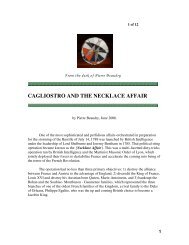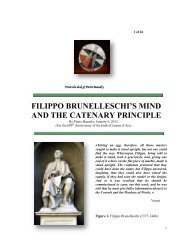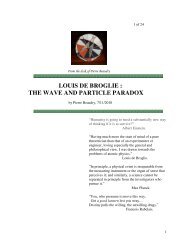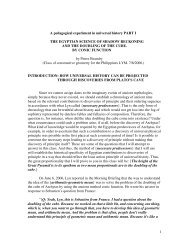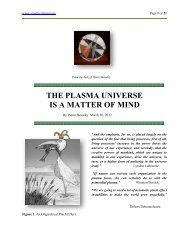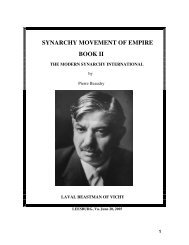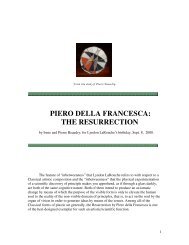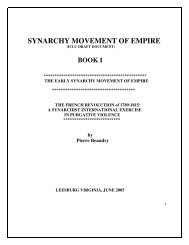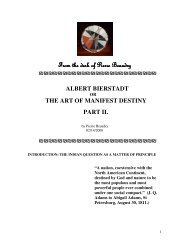3. HIPPARCHUS ASTROLABE.pdf
3. HIPPARCHUS ASTROLABE.pdf
3. HIPPARCHUS ASTROLABE.pdf
- No tags were found...
You also want an ePaper? Increase the reach of your titles
YUMPU automatically turns print PDFs into web optimized ePapers that Google loves.
The Hipparchus Conical Stereographic Projection represents a fundamentaldiscovery of a universal physical principle, as Lyn developed with his idea of the{principle of invariance} in his {So, You Wish to Learn All About Economics}. As Lynput it:{For us, as for Riemann, experimental physics centers upon those {uniqueexperiments} which prove mathematical (geometrical) hypotheses pertaining to thecontinuous manifold by means of experimental observations made in terms of theprojected images of the discrete manifold. This possibility depends upon a geometricalprinciple of topology, {invariance}. In first approximation, {invariance} identifies thosecharacteristic features of the geometry of a continuous manifold which are“preserved” through the process of the projection as characteristics of the images ofthe discrete manifold. In second approximation, higher-order invariances identifythose changes in the continuous manifold as transformations in invariants of thediscrete manifold. {Relativistic transformations in the metrical properties of action} inthe discrete manifold belong to this second, higher-order class of projectiveinvariances. A {unique experiment} has as its subject-matter such a higher-ordertransformation in metrical characteristics of principles of action in a discrete manifold.Riemann’s 1859 treatise on shock-wave generation is a model of the principles of{unique experiment.}} (p. 56-57)I venture to say, here, that the discovery of Hipparchus was such a {uniqueexperiment}. It is also a direct reflection of Plato’s {stereo-idea} of the dynamics of theuniverse as a whole. So, the Hipparchus discovery was much more than the discovery ofan astronomical instrument. What his discovery represented, in terms of technologicaladvance, was the most important instrument of astronavigation mapping of the heavenlysphere, from any point on Earth, and which is still in use today. Furthermore, from thestandpoint of an epistemological advance in fundamental science, the Hipparchusdiscovery was a {crucial experiment} in that it gave a glance into the higher-orderinvariances that Lyn is referring to, by identifying and providing the solution to threeimportant paradoxes of {Sphaerics}, or of astrophysics.First, there is the paradox of the Sun going in and out of the Universe. It is not atrue paradox, like the squaring of the circle, but it does reflect the true ingenuity ofinvention of Hipparchus, and his keen ability in problem solving. The key to solving thatparadox was to find a way to express the astrophysical event of the Equinoxes. Study theprojection of Figure 2, for a moment, and see if you can decipher the conic functionbehind the intersection of those two circles in the plane. Think of the whole projection astransformations within the continuous manifold.The stereographic projection from the complete quadrilateral overlapping thesphere in Figure 1 (4) establishes a relationship between the outside and the inside of thesphere such that the Ecliptic cycle can be extended proportionately, that is to say,lawfully, outside of the celestial sphere itself and be reflected onto the plane of the Solar5
transformation, you can restitute the physical-space-time of any astrophysical event asviewed from any geographic location you choose to go to and maintain the invariance ofthe universal characteristics.The modern description of stereographic projection, however, has somewhatstultified this amazing projective property of invariance from the spherical figures asHipparchus established them, and as they were later developed by Monge and Poncelet atthe Ecole Polytechnique, in Paris. The two main projective properties of spherical stereogeometryare that any circle of the surface of the sphere may be projected onto a plane asits inversion circle, and that since all spherical and plane angles are conic functions, theyare all proportional. This type of stereo-geometry was also replicated in the United Statesat the West Point Military Academy by Charles Davies, as part of his class in{Descriptive Geometry}, which he gave during a period of over 20 years, beginning1817.Figure 4. [Sphere Almucantars and Azimuths.]9
Personal Astrolabe, as if in the simultaneity of eternity. Then, surprisingly, you findyourself perplexed to discover that the dynamics of your PA is more precise and morereal than the mechanics of your PC!Figure 6. [The Astrolabe for Leesburg Virginia, 2005.]So, in conclusion, this is what I meant by the Image of God. This new center ofthe universe, which is represented by your {Zenith Function}, is not an egocentric pointaround which the universe turns, like the Satanist, Felix Rohatyn, who thinks that theworld turns around him. The {Zenith Function} is the self-fulfilling function of the rolethat you have to play in the universe as a scientist and political leader, the function thatKing Bulan of the Khazars Kingdom had chosen to adopt for himself, in order to be in theproximity of God. The irony is that those two different poles of the celestial spherebecome proportional {as if in a glass darkly} inside of Plato’s Cave, making visible inthe night sky the discovery of Hipparchus by combining, proportionately, the intelligencein the heavens with your own powers of reason. That is what I wanted to convey to youas the Riemannian {Geistesmassen-Stereo-form} of the invariant relationship betweenthe continuous manifold and the discrete manifold. This is what the universe looks likefrom the standpoint of principles as opposed to sense perception and which reflects thepower of the creative process itself. See you in two weeks.FIN PART III, August 5, 2006.11




